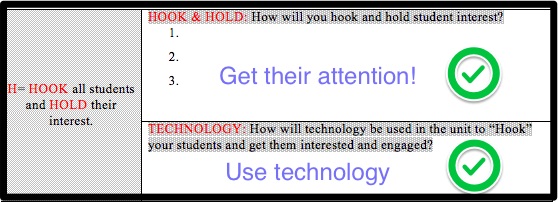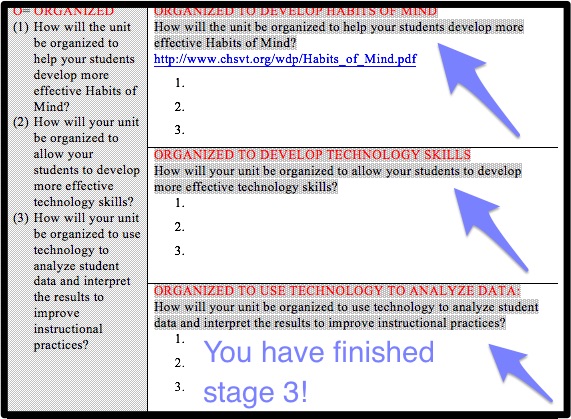Developing a Learning Plan
In the third stage of the UbD template, you will develop your learning plan, keeping in mind alignment with the learning goals established in stage one and the assessments developed in stage two. Stage one and two are designed and written for and by the instructor. The instructor writes stage three for the student. Wiggins and McTighe (2012) suggest that all learning goals should be engaging and effective. An engaging assignment or assessment will keep a student interested and thinking throughout the class period. Rote memorization, passive learning, and completing worksheets are not engaging work. Effective assignments are ones that lead to better understanding and the ability to transfer these understandings outside of the classroom or apply them more abstractly.
“Life can only be understood backwards; but it must be lived forwards.”
― Søren Kierkegaard
To facilitate the design of engaging and effective educational experiences, Wiggins and McTighe developed a helpful acronym:
W- The question words: Where and why? Where are we headed as far as understandings, and where have we come from? Why do we need these understandings? Students are much more likely to achieve if they understand, why, and how they are going to learn something.
H- To develop an engaging assignment for the learning plan, there needs to be a hook to hold on to the student’s interest.
E- For students to most effectively understand and make meaning of their learning and transfer it effectively, we need to equip them with the appropriate knowledge and skills and provide experiences that will scaffold them as they make leaps in understanding.
R- The final product is more valuable if it is not really final. Give students useful and informative feedback and allow them to rethink, revise, and reflect based on that feedback.
E- To become a lifelong learner, learners need to develop effective metacognition skills. They must be able to evaluate themselves in terms of academic strengths and weaknesses, as well as the depth of their understandings.
T- All learners do not have the same skills and backgrounds. A skilled instructor will tailor the learning plan so that it can meet the different levels of understanding of the learners, with the ultimate goal that all learners make meaning and meet the understanding goals as well as be evaluated with equivalent assessment criteria.
O- Organize the learning plan so that it has a natural progression, makes sense to the learner, and leads to understandings (Wiggins & McTighe, 2012).
There are also three distinct types of learning:
Acquisition: These are the facts and skills that the student needs to acquire to be prepared for higher stages of learning. Teaching these facts and skills can be in the most efficient way possible.
Meaning-making: In this stage, learners intellectually wrestle with the information they have learned. They learn to categorize this content and determine the implications. Students will form theories that they intellectually test to build connections and patterns.
Transfer: After the learner has made sense of their learning content, they learn to apply it to circumstances other than ones in which they initially discovered it. In this stage, the teacher serves as a coach and gives feedback to the student as they work autonomously (Wiggins & McTighe, 2012).

Wiggins and McTighe (2012) suggest coding all the learning activities as A, M, or T, and they provide a list of verbs that instructors can use when writing their learning goals to aid in putting them in the correct category.
Since the ability to transfer is the ultimate goal of UbD course design, Wiggins and McTeague (2012) make the following suggestions to aid in this process.
- Learners should practice using multiple skills
simultaneously with coaching and feedback from the instructor.
- Students should be encouraged to make use of all
of their prior knowledge and constantly relearn, reword, and rephrase their
understandings.
Differentiating Learning:
The focus of stage three is the learner. It helps to think of a class as individual students instead of as a group. Each individual comes to a course with his/her educational background, goals, and skills. It is not practical, nor suggested, to differentiate all aspects of the curriculum. The learning goals should stay the same for all students, but the acquisition of knowledge needed, and the assessments used to determine competencies may vary. Pre-Assessments can be used to assess student strengths and weaknesses before starting a unit.
Carol Ann Tomlinson (1999) suggests that instructors can differentiate the content used, the way the students will work with that content, and the expected product of their work. An instructor can use the student’s readiness or background and their learning profile to help guide the need for differentiation (Wiggins & McTighe, 2012).
Organizing the Learning Plan:
One of the most important aspects of curriculum design is developing the learning plan, so it makes sense to the learners, is engaging, and will lead to understanding. The unit is not completed when it is written. A continuous improvement plan includes seeking feedback from peers as well as experts in the field to make sure the unit makes sense, and it is easy for another educator to follow.
While teaching the lesson, an instructor will closely watch to ensure that the lesson is meeting the goals for the students as well as seek feedback from the students as they work. Finally, the instructor will base the success of the lesson plan on the success of the students since their ability to make meaning and understand the content is the reason the lesson plan was developed (Wiggins & McTighe, 2012).

Just like it is nice to know where you are going on a trip, it is helpful for students to see where the learning plan is headed and why it is headed that way. If students have a clear goal for their learning, and it has value to them, they will be much more motivated to pursue the goal. In the goals section, instructors will list the SMART learning objectives for the students. These goals should be specific, measurable, attainable, results-focused, and time-bound. In the next section, the instructor will let the students know how these understandings will benefit them in their life and career. The last section will clearly define the information they are expected to come to the unit with, the information they will leave the unit with, and any misconceptions that may be identified along the way (Wiggins & McTighe, 2012).

Students don’t usually start a new unit excited and ready to begin. The instructor will need to get their attention and then hold that attention. Suggested ways of grabbing their attention include challenging questions, stories, personal connections, and contrasting perspectives or points of view. Technology can be used to aid in getting student attention (Wiggins & McTighe, 2012).
One temptation we are trying to avoid is “covering a unit or a textbook” instead, we want students to discover or uncover the material themselves. In this section, the instructor will list the experiences that are likely to aid the student in doing this. These experiences should allow the student to make meaning from the content and then be equipped to transfer this information to other settings and scenarios (Wiggins & McTighe, 2012).
Each time a student recalls information, it is stored in the brain in a slightly different way. This revision process is why our memories change over time. As the unit progresses and the student has more experiences and gathers more perspectives, they should rethink, revise, and reformulate their understandings. These revisions should not be considered a summative product, but instead, a path to understanding that deepens over time and with reflection (Wiggins & McTighe, 2012).
Autonomy and lifelong self-learning is the goal. Your goal as an instructor is to help students learn to assess their strengths and weaknesses instead of relying on you to do so. Metacognition is the process of reflecting on your thinking. Encourage students to seek feedback from others and then take the time to reflect on this feedback and use it to self-evaluate their progress (Wiggins & McTighe, 2012).
For your curriculum to fit all of your learners, it must be slightly tailored to meet the different needs, interests, and abilities of the learners. On the other hand, not everything in the curriculum should be differentiated, you have set learning goals, and all students should strive to reach them. They may need slightly different paths to the target.
Carol Ann Tomlinson feels that the curriculum can be differentiated by altering the content, by allowing a different learning process, by allowing different products to be developed and through a personalized learning environment. The instructor can assess the student’s readiness to learn through pretests and work with the student’s learning profile to develop these modifications (Tomlinson, 1999).

As you plan your lesson plan, you will need to check continually to make sure that it is aligned with the goals in stage one and the assessments in stage two. You will want to make sure that the plan makes sense to the learners and will most effectively lead to their ability to uncover the content and make meaning from it. Some things to consider are, do you intend to help your students develop habits of mind or improve their technology skills? Habits of mind are problem-solving skills that will help your learners more effectively operate in society. They are the life skills that people learn in several settings. As an instructor, you need to determine if it is your goal and responsibility to incorporate them into your content. (Costa & Kallick, 2009).
Students use technology, but how strong are their technology skills other than texting and posting? Consider if your unit will help them develop more academically oriented technology skills. In addition, how will you, as the instructor, use technology in the classroom and to analyze your student’s results. These results will lead to further modification and tailoring of your curriculum (Wiggins & McTighe, 2012).
References
References
Costa, A. L., & Kallick, B. (2009). Learning and leading with habits of mind: 16 essential characteristics for success. Alexandria: Association for Supervision & Curriculum Development.
Tomlinson, C. (1999) The differentiated classroom: Responding to the needs of all learners. Alexandria, VA: ASCD.
Wiggins, G. P., and McTighe, J. (2011). The understanding by design guide to creating high-quality units (2nd ed.). Alexandria, VA: Association for Supervision and Curriculum Development.
Wiggins, G and McTighe J (2012). The understanding by design guide to advanced concepts in creating and reviewing units (2nd ed.). Alexandria, VA: Association for Supervision and Curriculum Development Publishing.